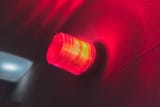Search Results
6/19/2025, 7:02:18 AM
>>279793381
>Rakka's sin-bound state is less severe than Reki's
I don’t think being “sin-bound” proves (or disproves) suicide. Its not related of how a Haibane died. It’s basically a warning light (pic related) that flashes when she’s trapped in guilt and can’t take her Day of Flight.
The show presents two flavors of sin-bound :
Reki : chronic case. Born sin-bound, black feathers from day one, a steady symptom of deep self-loathing that lasts seven years.
Rakka : acute case. She is born fine, but after Kuu’s Day of Flight her grief spikes and her feathers darken in seconds. But she manage to works through it in a matter of weeks.
So “severity” isn’t about how they died. It’s about how long unresolved guilt keeps festering. Any Haibane who clings to despair can’t transcend and risks lingering in Glie indefinitely.
I still think every Haibane was a suicide victim, but only those who can’t let go of their negative emotions stay (or become) sin-bound.
>Rakka's and Reki's dreams are very different. Rakka's dream is vague, and her role in it is entire passive
True, but that vagueness is what you would expect from someone coping with the memory of her own suicide. Trauma survivors often rewrite events in softer focus or shift into a spectator’s role because admitting “I chose to jump” is too painful. Rakka literally sees herself falling without remembering the step that began the fall, the mind blanks out the decisive moment to be in denial.
>Reki's dream has a clear meaning
Reki, by contrast, remembers every detail of walking onto the tracks. Her self-loathing keeps the memory raw and explicit. Rakka’s psyche has already started numbing the wound, so her dream feels hazier and more passive, it’s the same act, viewed through a coping filter.
tl;dr : Being sin-bound, or having different dreamsdoesn’t disprove the suicide theory. The differences simply show how each different Haibane copes with the same situation, their death.
>Rakka's sin-bound state is less severe than Reki's
I don’t think being “sin-bound” proves (or disproves) suicide. Its not related of how a Haibane died. It’s basically a warning light (pic related) that flashes when she’s trapped in guilt and can’t take her Day of Flight.
The show presents two flavors of sin-bound :
Reki : chronic case. Born sin-bound, black feathers from day one, a steady symptom of deep self-loathing that lasts seven years.
Rakka : acute case. She is born fine, but after Kuu’s Day of Flight her grief spikes and her feathers darken in seconds. But she manage to works through it in a matter of weeks.
So “severity” isn’t about how they died. It’s about how long unresolved guilt keeps festering. Any Haibane who clings to despair can’t transcend and risks lingering in Glie indefinitely.
I still think every Haibane was a suicide victim, but only those who can’t let go of their negative emotions stay (or become) sin-bound.
>Rakka's and Reki's dreams are very different. Rakka's dream is vague, and her role in it is entire passive
True, but that vagueness is what you would expect from someone coping with the memory of her own suicide. Trauma survivors often rewrite events in softer focus or shift into a spectator’s role because admitting “I chose to jump” is too painful. Rakka literally sees herself falling without remembering the step that began the fall, the mind blanks out the decisive moment to be in denial.
>Reki's dream has a clear meaning
Reki, by contrast, remembers every detail of walking onto the tracks. Her self-loathing keeps the memory raw and explicit. Rakka’s psyche has already started numbing the wound, so her dream feels hazier and more passive, it’s the same act, viewed through a coping filter.
tl;dr : Being sin-bound, or having different dreamsdoesn’t disprove the suicide theory. The differences simply show how each different Haibane copes with the same situation, their death.
Page 1
